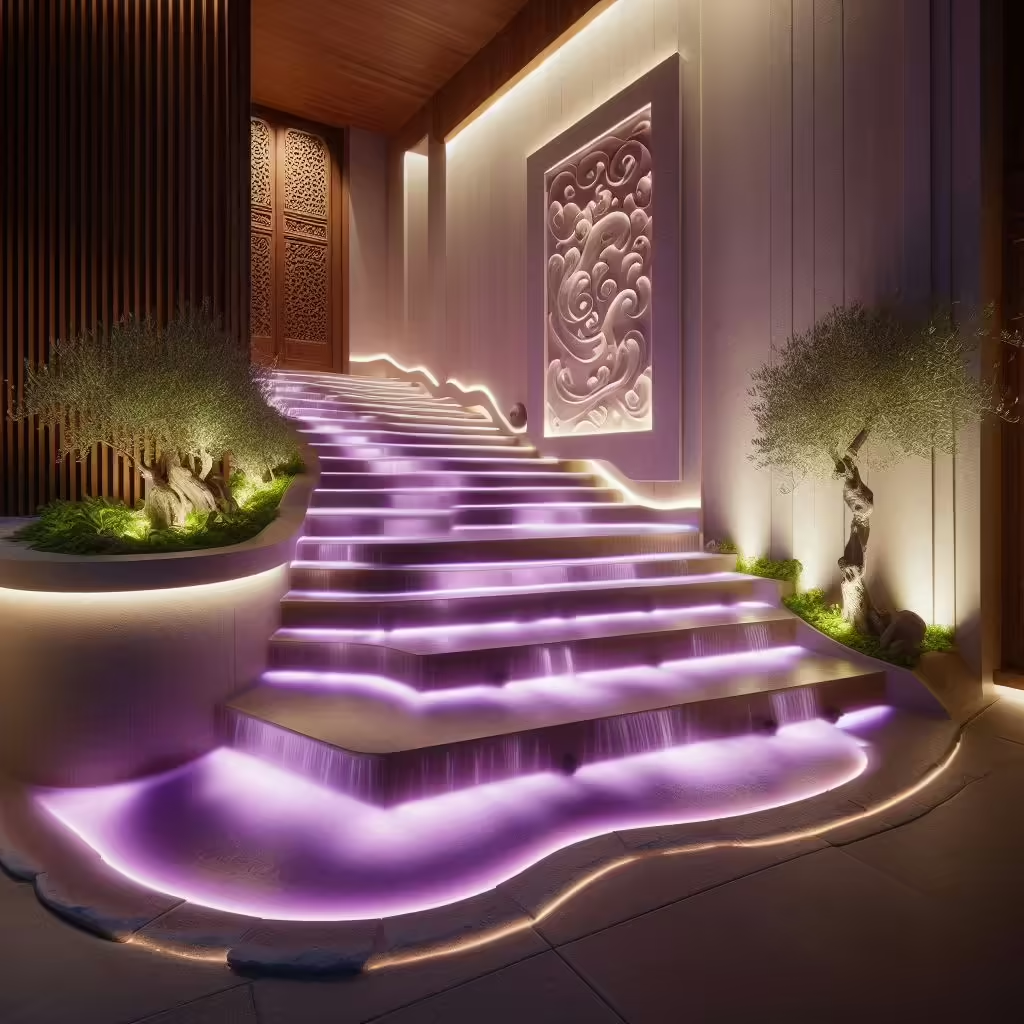When it comes to home design, staircases are often overlooked. However, with modern architectural trends focusing on blending functionality and aesthetics, the waterfall-inspired staircase has become an innovative way to add both luxury and natural beauty to your home. Just as a waterfall creates an aura of tranquility and movement in nature, a waterfall staircase brings fluidity and elegance to any interior.
In this post, we’ll explore everything from design inspiration and material choices to practical considerations, ensuring you have all the details you need to bring this captivating feature into your living space.
What Is a Waterfall-Inspired Staircase?
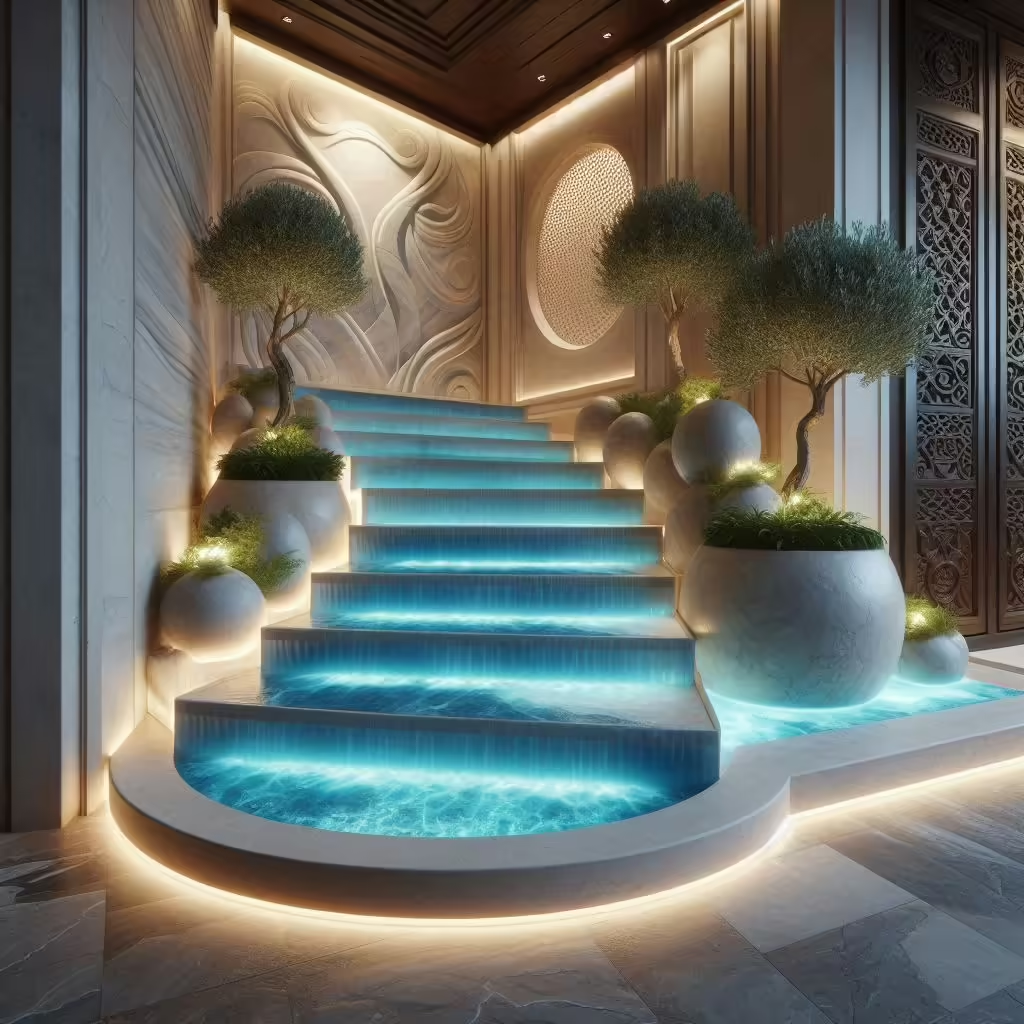
A waterfall-inspired staircase is a unique design concept that mimics the fluid movement of a cascading waterfall. Instead of standard, rigid steps, the staircase features curves and smooth transitions that create the illusion of water flowing down. This design integrates the essence of nature into modern interiors, offering not only functionality but also a stunning visual element.
Whether it’s through the use of materials like glass, stone, or wood, or with an illuminated structure that highlights each step, this style of staircase aims to evoke the calm, steady flow of water, making your home feel like a serene retreat.
The Growing Popularity of Nature-Inspired Designs
As homeowners search for ways to make their spaces more calming and connected to the outdoors, the biophilic design trend is gaining momentum. Incorporating natural elements, such as plants, natural light, and water features, has become a key way to transform modern living spaces. Waterfall-inspired staircases are an extension of this movement, blending cutting-edge design with the soothing qualities of nature.
Key Features of a Waterfall-Inspired Staircase
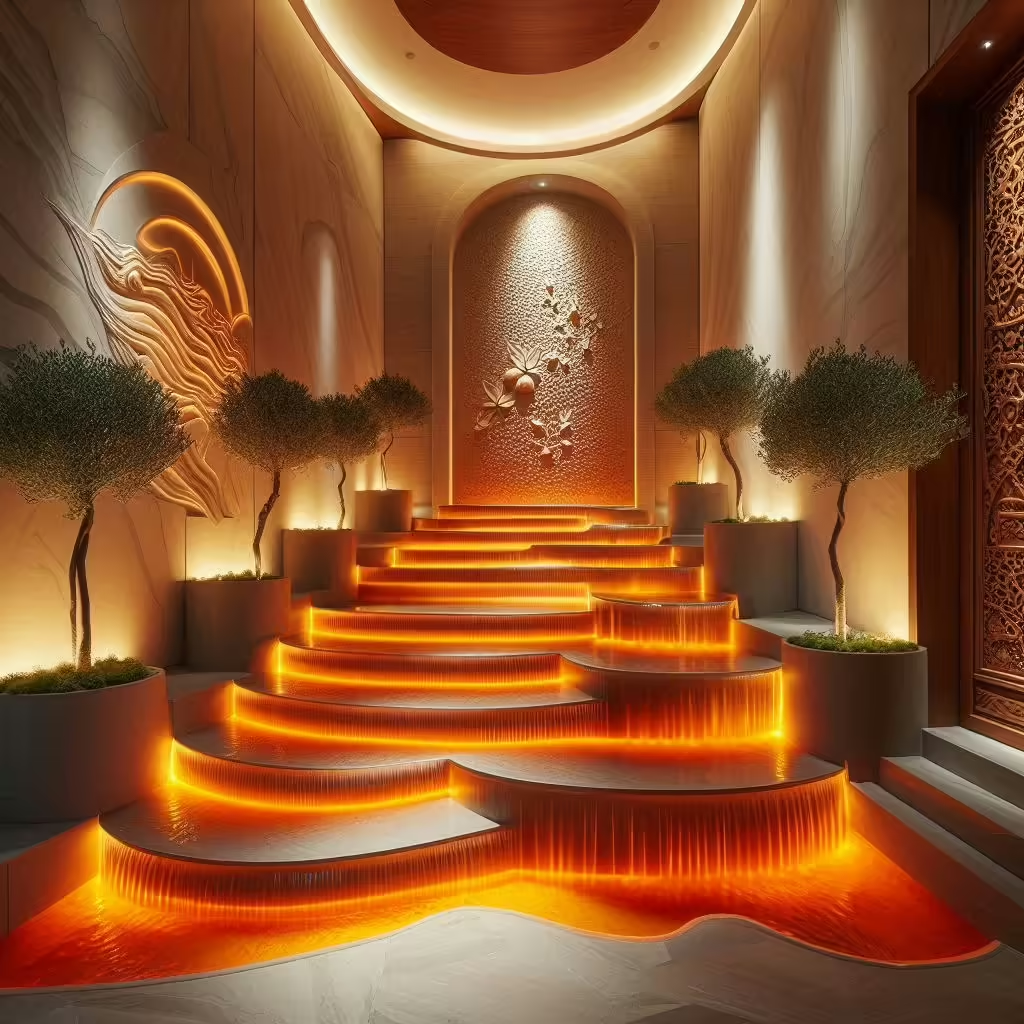
To create a waterfall-inspired staircase, designers focus on key elements that evoke the essence of water. Here are the most defining features:
Curved Steps and Soft Edges
The hallmark of any waterfall-inspired staircase is its smooth, curved lines. Unlike traditional staircases that have sharp, angular steps, waterfall-inspired designs flow gracefully, making each step look as if it’s part of a continuous, cascading stream.
Use of Reflective and Transparent Materials
Materials such as glass, polished metal, or marble help to emphasize the fluidity of the design. Glass balustrades or steps add transparency, which further enhances the waterfall effect. For a more natural look, some designs may incorporate stone or wood elements that blend with the surroundings.
Integrated Lighting
Lighting plays a critical role in waterfall-inspired staircases. LED lights embedded in the steps or under the handrails can simulate the sparkle and shimmer of water. Adjustable lighting can also create different moods, whether you want a peaceful ambiance or a more dramatic effect at night.
Minimalist Handrails
To keep the focus on the flow of the stairs, handrails are often minimalist in design. Many waterfall-inspired staircases use glass or thin metal railings to maintain a sense of openness and fluidity.
Seamless Integration with Water Features
For a truly immersive experience, some designs incorporate actual water features, such as small streams or fountains along the staircase. This brings the sound and movement of water into the space, further enhancing the natural atmosphere.
Similar products: Only Here!
Materials to Use for a Waterfall-Inspired Staircase
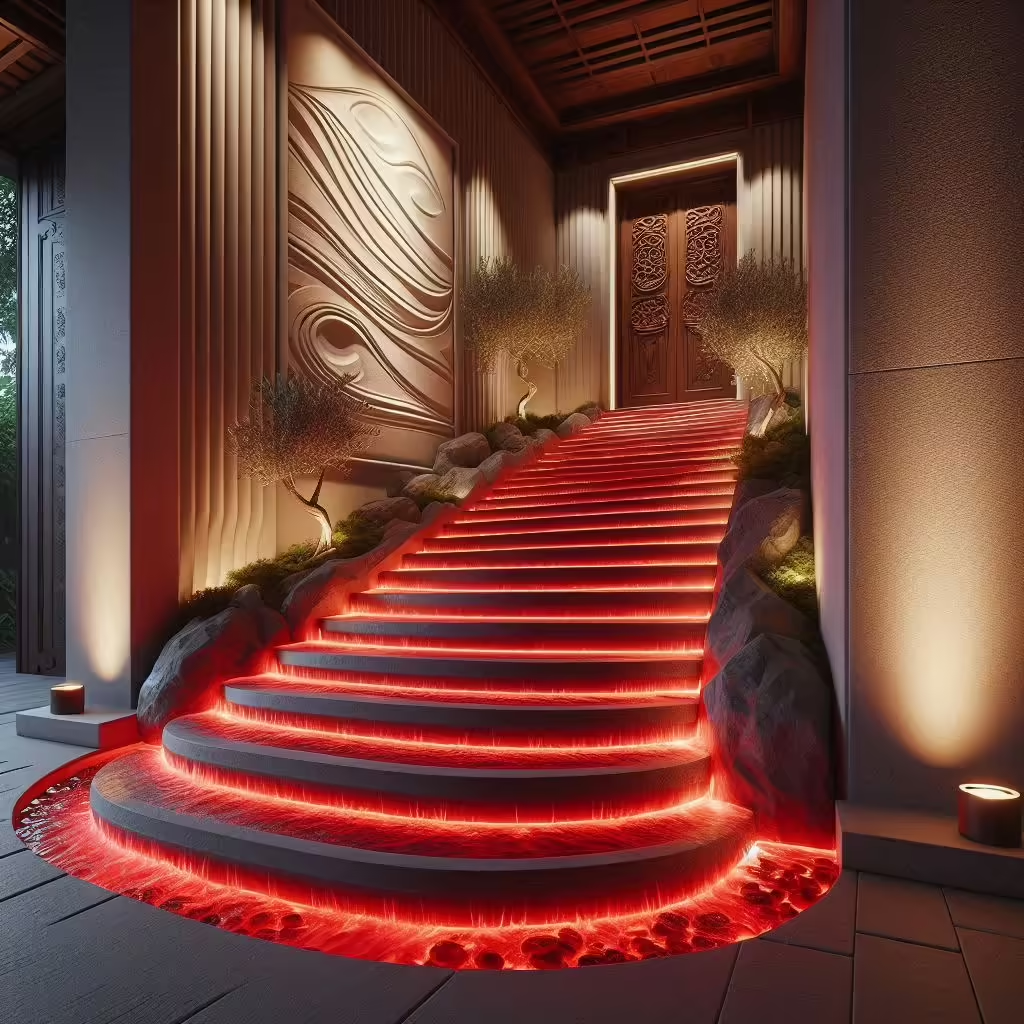
Choosing the right materials is essential to achieving the waterfall effect. Here are some popular options:
Glass
Glass is one of the most common materials used in waterfall-inspired staircases. Its transparency allows light to pass through, enhancing the overall flow and openness of the space. Glass steps or balustrades give a contemporary look that works well with minimalist or modern interiors.
Stone
For those who prefer a more natural, earthy look, stone is an excellent choice. Stones like marble or granite can be sculpted to create curved steps that resemble the smoothness of water-worn rocks. The natural texture of stone adds depth and character to the design.
Wood
Wood is a versatile material that can add warmth and texture to a waterfall staircase. Curved wooden steps paired with metal or glass railings can create a stunning contrast, bringing together natural and modern elements.
Metal
Polished metals, such as stainless steel or aluminum, are often used in minimalist designs. Metal can be shaped into sleek, curved forms and reflects light, making it a good option for those looking to enhance the reflective qualities of the staircase.
How to Design Your Waterfall-Inspired Staircase
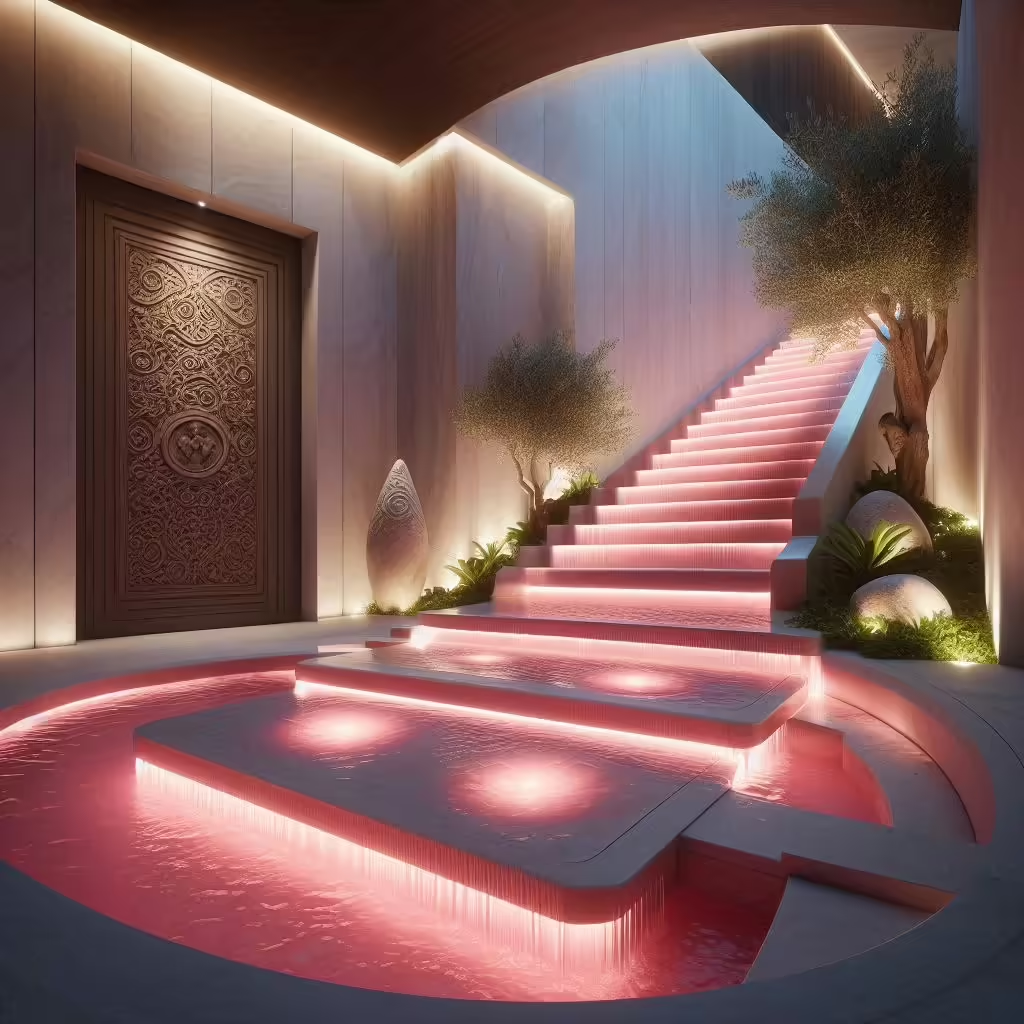
Designing a waterfall-inspired staircase requires thoughtful planning. Here are some key considerations to keep in mind when working with an architect or interior designer:
Assess the Space
Before diving into design, assess the available space in your home. The curvature and flow of the waterfall-inspired staircase will need enough room to make an impact. Homes with open floor plans or grand entryways are ideal for showcasing this style.
Choose the Right Materials
As discussed earlier, material choice plays a significant role in the overall look of the staircase. Your selection will depend on the design style you’re aiming for. Glass and metal are perfect for modern aesthetics, while stone and wood add a more organic feel.
Consider Lighting
Lighting can make or break a waterfall-inspired staircase. Work with a lighting designer to integrate LED lights into the steps, risers, or along the walls. Properly placed lighting can emphasize the fluidity of the staircase and create a captivating visual effect.
Work With an Experienced Architect
Designing a staircase that is both functional and artistic is no small feat. It’s crucial to work with an experienced architect or interior designer who understands the structural requirements of curved stairs while maintaining the aesthetic you desire.
Benefits of a Waterfall-Inspired Staircase
Waterfall-inspired staircases are not just about aesthetics; they offer several benefits to homeowners:
Increased Property Value
Architecturally unique features like a waterfall-inspired staircase can significantly boost the value of your property. This type of staircase is seen as a luxury design element, making your home stand out in the real estate market.
A Soothing Environment
The flowing, natural design of a waterfall-inspired staircase helps to create a peaceful atmosphere. The gentle curves and use of calming materials like glass and stone make it the perfect addition for those seeking to bring more serenity into their homes.
Timeless Appeal
The design of a waterfall-inspired staircase is both modern and timeless. Its organic shape ensures that it won’t go out of style, making it a long-lasting feature that can adapt to changing trends in interior design.
Customization Options for a Unique Look
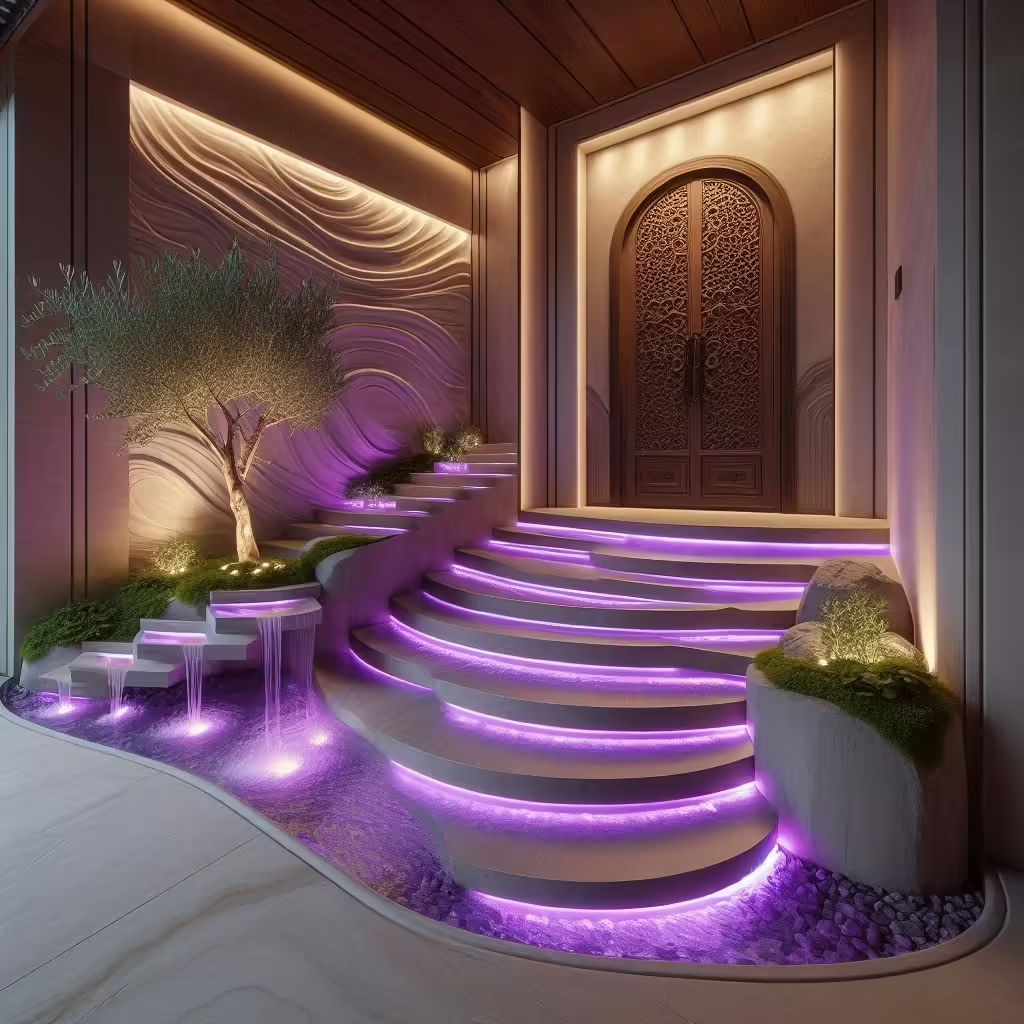
If you want to personalize your waterfall-inspired staircase, there are several ways to customize the design to fit your home’s style:
Add Water Elements
For a truly unique experience, you can incorporate actual water elements, such as small fountains or a running water feature alongside the staircase. This adds both visual appeal and soothing sounds to the space.
Patterned Glass or Etched Stone
For a more decorative look, consider adding patterns or textures to the glass or stone elements of the staircase. Etched designs on the glass or sculpted stone can create intricate visual effects that enhance the waterfall motif.
Color Accents
While most waterfall-inspired staircases are kept in neutral tones to mimic the natural elements, adding color can make the staircase pop. Use colored LED lighting or opt for materials like tinted glass or metal for a bold statement.
Smart Integration
To keep the space technologically advanced, you can integrate smart features into the staircase. For example, motion sensors can automatically adjust the lighting as you approach, or you could use smart home systems to control the ambiance of the staircase area.
Similar products: Only Here!
Safety Considerations for a Waterfall-Inspired Staircase
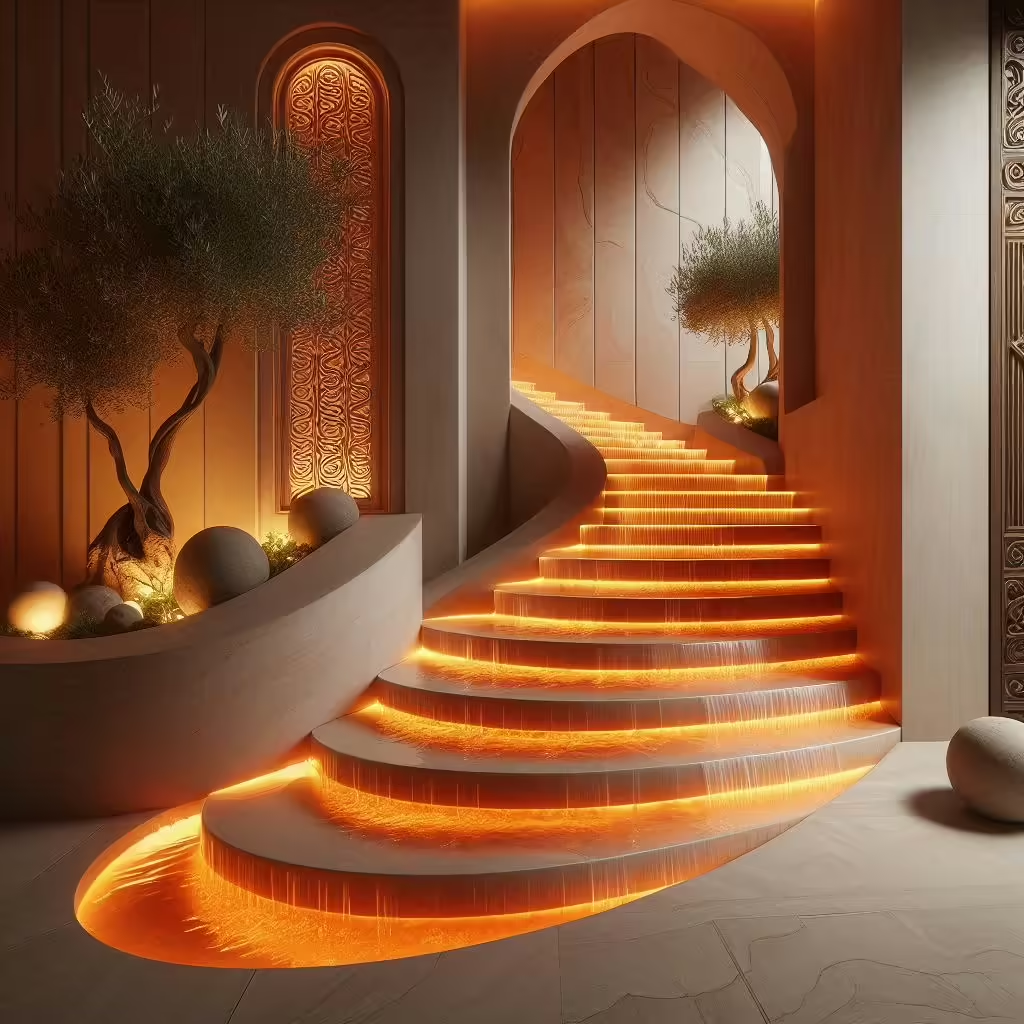
While waterfall-inspired staircases are beautiful, safety should always be a top priority. Here are a few considerations to ensure that your staircase is both safe and stylish:
Non-Slip Surfaces
Smooth surfaces like glass or polished stone can become slippery, especially if they get wet. Consider adding non-slip coatings to the steps or using textured materials to prevent accidents.
Secure Railings
Even if you want a minimalist look, sturdy railings are a must. Glass or metal railings should be securely fastened and designed to provide adequate support.
Proper Lighting
Good lighting is not just for aesthetics; it’s crucial for safety. Ensure that your staircase is well-lit at all times, especially at night, to prevent missteps.
Integrating a Waterfall-Inspired Staircase Into Different Home Styles
One of the most impressive aspects of a waterfall-inspired staircase is its versatility. Whether you live in a sleek, modern city apartment or a rustic country house, this design can be adapted to fit various architectural styles. Let’s explore how this fluid, natural design can seamlessly blend into different home aesthetics.
Modern and Minimalist Homes
Waterfall-inspired staircases are often seen in modern and minimalist homes due to their clean lines and contemporary materials like glass and metal. In such homes, the focus is on simplicity and function, and a waterfall staircase adds an artistic flair without compromising the minimalist aesthetic. Opt for transparent glass steps with hidden lighting to create a floating effect, maintaining the open, uncluttered feel of the space.
Rustic and Natural Interiors
For more rustic homes, such as cabins or farmhouses, the waterfall-inspired staircase can be customized with natural materials like wood and stone. The curved design mimics the flow of nature, perfectly complementing the raw, earthy tones of a rustic interior. Reclaimed wood steps or natural stone risers can emphasize the organic beauty of the space while still providing a sophisticated design element.
Luxury Mansions
In luxury homes, waterfall-inspired staircases become grand, sculptural statements. Using high-end materials like marble or onyx, and incorporating intricate lighting systems, the staircase can be the focal point of an opulent foyer or living area. The addition of waterfalls or water features running alongside the staircase elevates the luxury factor, making the staircase both a work of art and a functional element.
Eclectic or Bohemian Homes
For more eclectic or bohemian interiors, the waterfall-inspired staircase can be a playful and creative feature. Use vibrant colors, patterned tiles, or hand-painted designs on the steps to make the staircase a focal point that reflects the unique, artistic nature of the home. Pair this with greenery, like cascading plants, to enhance the organic, natural feel of the design.
Incorporating Waterfall-Inspired Staircases in Commercial Spaces
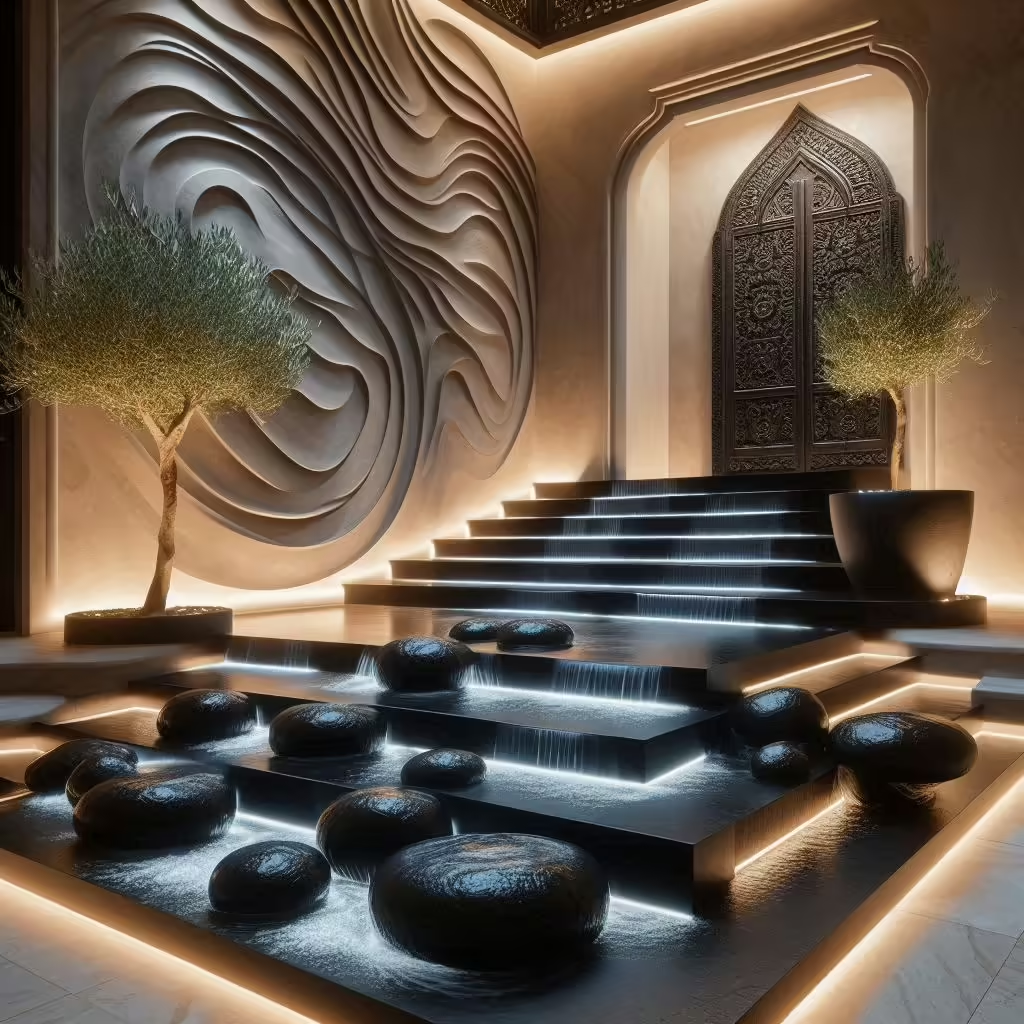
While residential homes are often the first place people think of when imagining a waterfall-inspired staircase, this design can also be incredibly impactful in commercial spaces. Restaurants, hotels, and corporate offices can use these stunning staircases to create a memorable first impression.
Hotels and Luxury Resorts
In hotels and resorts, first impressions matter. A waterfall-inspired staircase in the lobby can immediately signal luxury and relaxation to guests. With a combination of flowing lines, reflective surfaces, and soft lighting, these staircases can help create a serene, welcoming environment. Resorts that already incorporate natural elements such as gardens or water features can use the staircase to bridge indoor and outdoor spaces.
Restaurants and Lounges
In high-end restaurants or lounges, the staircase can serve as a dramatic design feature, guiding patrons to an upper floor while reinforcing the venue’s overall aesthetic. Paired with dim lighting and reflective surfaces, the waterfall-inspired staircase can enhance the intimate, upscale atmosphere of the space.
Corporate Offices
For corporate offices looking to make a bold design statement, a waterfall-inspired staircase is a modern and artistic way to showcase innovation. By incorporating this element into the design of a lobby or common area, companies can demonstrate a forward-thinking, creative approach to design, making an impression on both employees and clients.
Maintenance and Care Tips for a Waterfall-Inspired Staircase
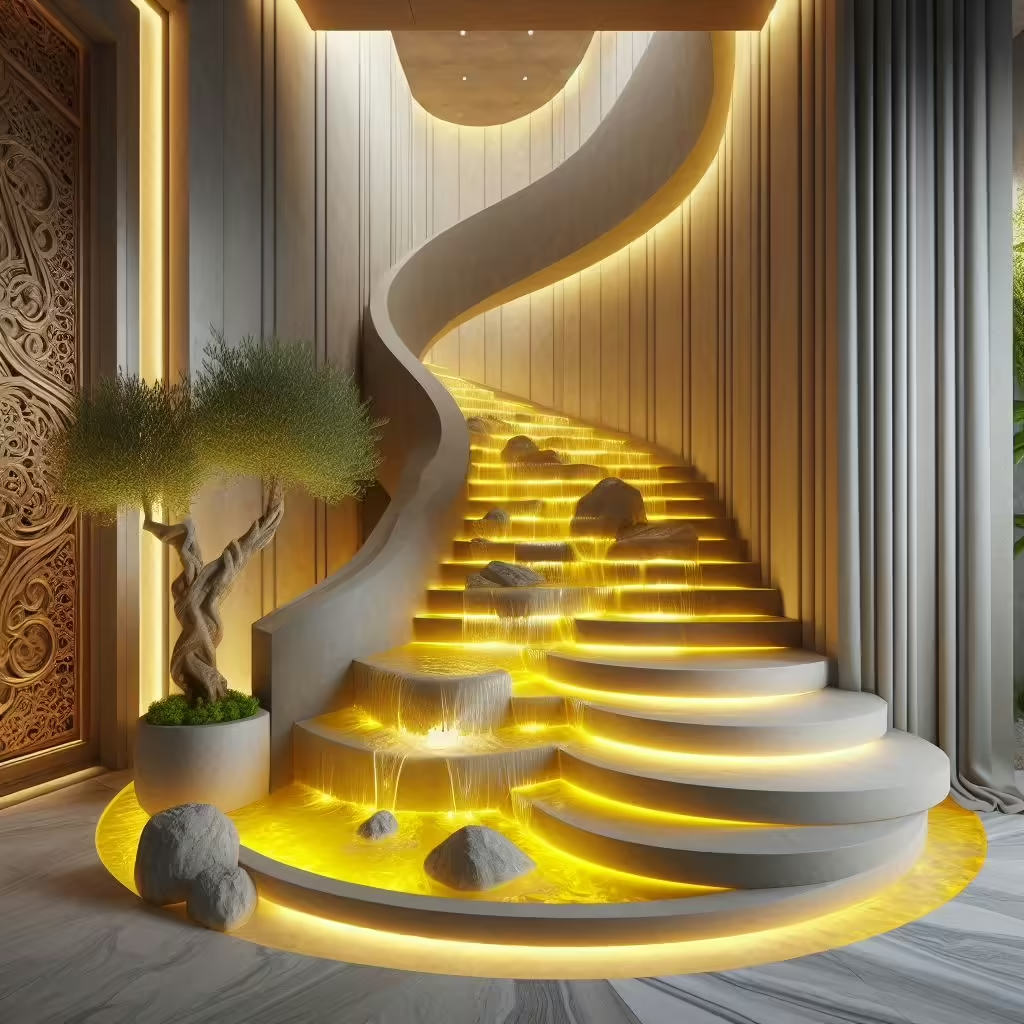
While waterfall-inspired staircases are beautiful, they require regular care to maintain their stunning appearance. Depending on the materials used, different care and maintenance routines will be necessary to keep your staircase looking its best.
Glass Maintenance
If your staircase features glass steps or railings, cleaning will be a priority to keep the transparency and shine intact. Use a glass cleaner and soft cloth to regularly remove fingerprints and smudges. For safety, ensure the glass is tempered and scratch-resistant to withstand daily use.
Wood Maintenance
Wooden steps or railings need regular polishing and dusting to prevent wear and tear. Depending on the type of wood, you may also need to reapply sealant or varnish periodically to protect the surface from moisture or scratches.
Stone and Metal Care
For stone or metal staircases, you may need specialized cleaning products to maintain their sheen. Marble and granite steps can be polished to enhance their natural beauty, while metals like stainless steel require non-abrasive cleaners to prevent rust or tarnish.
Lighting Maintenance
LED lighting systems installed within or around the staircase should be checked regularly to ensure that all lights are functioning properly. Some systems may need bulb replacements or adjustments, and it’s a good idea to work with a professional to maintain the electrical components.
Sustainable Design Options for a Waterfall-Inspired Staircase
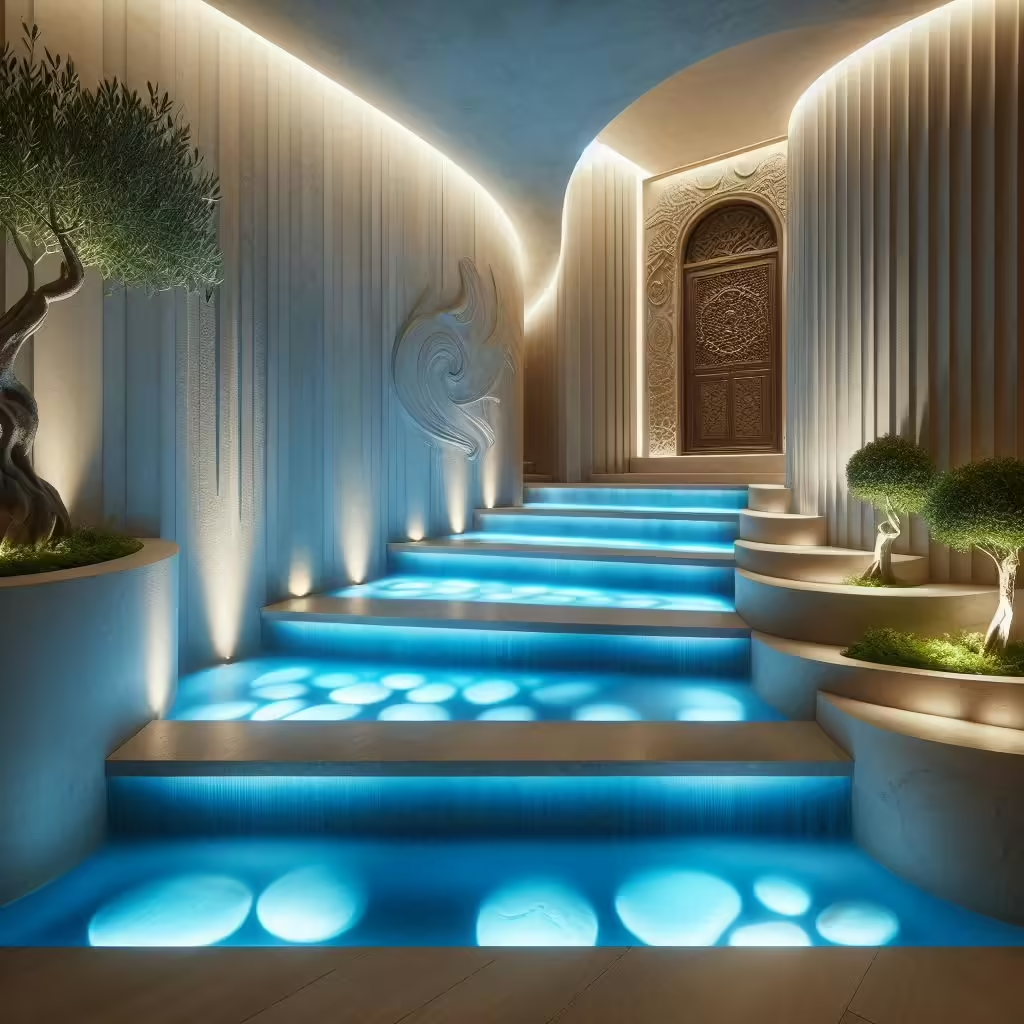
In an era where sustainability is at the forefront of design, creating a waterfall-inspired staircase with eco-friendly materials is an appealing option for environmentally conscious homeowners. Here’s how you can incorporate sustainability into your staircase design:
Reclaimed Wood
Using reclaimed or recycled wood for your staircase is an excellent way to reduce your environmental footprint. This adds a rustic charm to the staircase and ensures that no new trees are cut down for the construction.
Energy-Efficient Lighting
Install energy-efficient LED lighting systems that consume less power while still providing the same ambient effect. Solar-powered lighting systems can also be an option for homes with access to ample natural light.
Natural Stone and Eco-Friendly Finishes
When selecting stone, choose local, natural materials to reduce the carbon footprint associated with transportation. Additionally, using non-toxic, eco-friendly finishes and sealants will ensure that your staircase is safe for both your family and the environment.
Similar products: Only Here!
Conclusion: Elevating Your Space with a Waterfall-Inspired Staircase
A waterfall-inspired staircase is more than just a way to move from one floor to another—it’s a transformative piece of art that adds beauty, tranquility, and elegance to any space. Whether you’re creating a modern, minimalist masterpiece or adding a natural, rustic touch to your home, this staircase design captures the timeless beauty of flowing water and brings it indoors.
By carefully selecting materials, incorporating lighting, and considering how this feature fits into the overall design of your home or commercial space, you can make the most of this stunning architectural feature. The fluid curves and seamless integration of nature-inspired elements make the waterfall-inspired staircase a unique addition that will leave a lasting impression on anyone who steps inside your home.
With endless customization possibilities, from actual water features to innovative lighting and materials, a waterfall-inspired staircase is a perfect blend of form and function. Not only does it enhance the aesthetic appeal of your space, but it also contributes to a serene, calming environment, making it the ideal choice for those seeking to elevate their interior design.

